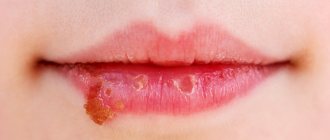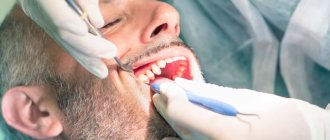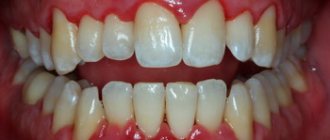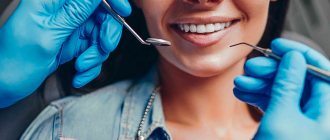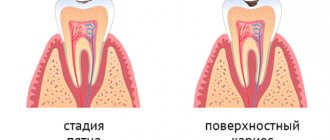The essence of the procedure
Fluoridation is the saturation of enamel with fluorides, as well as other essential minerals.
During manipulation, fluoride ions penetrate the crystal lattice of the enamel and strengthen it. As a result, teeth become stronger, the enamel is dense and hard, less susceptible to adverse factors. Please note that the fluoridation procedure can often be medicinal in nature, that is, it helps strengthen teeth and enamel, and therefore requires the intervention of a professional dentist.
You can learn more about dental fluoridation and the list of treatment procedures from our page. MAKE AN APPOINTMENT
HEALTHY “FOOD” FOR TEETH. Fluoridation of teeth.
Bodrenkova Elena
Hygienist at the Ekostom dental clinic
How effective is this technique? Is it safe? How exactly is it carried out?
There are a lot of questions, and they all require answers. The time has come to fill the gaps in knowledge, and at the same time debunk myths and dispel rumors.
Question one: why do you need fluoridation of teeth?
Most dentists will tell you that this is perhaps the only way to protect tooth enamel, prevent tooth decay (apart from good hygiene and proper nutrition, of course), and also reduce tooth sensitivity. Is it so? In what cases is the procedure effective and in what cases is it not? What does fluoridation do?
SO WHAT IS FLUORIDE?
Fluorine is a gas, and in nature it is often found in compounds with other substances: for example, calcium fluoride or sodium fluoride. Fluoride is the fluoride ion. All organic and inorganic compounds containing fluorine are fluorides, which will be discussed in this article. Fluoride is a natural element that is part of the earth's crust. Therefore, it is natural that a small dose of it (considerably less than one part per million) is contained in natural water. Plants absorb these compounds, so small amounts of fluoride are present in all our food and water, and also accumulate in animal tissue and plants.
LET'S REMEMBER A LITTLE HISTORY
The first statements that fluoride was good for teeth, as well as that it should be added to drinking water to prevent dental disease, were made by doctors Gerald Cox and Harold Hodgy. They became the main defenders of the fluoridation theory. Hoxha was responsible for numerous works in support of the water fluoridation program and its implementation by 1957.
So, what happens to the teeth, why strengthen them?
Metabolic processes constantly occur in teeth. Many people have probably heard more than once about such a phenomenon as the acid-base balance, which must be restored every time after eating. This is explained by the fact that after eating, the pH of the oral cavity becomes acidic. To neutralize this condition, the process of “washing out” microelements from tooth enamel into the oral cavity is activated. This process is called demineralization. If it becomes dominant over the processes of remineralization, then defects appear in the enamel, which subsequently open the way for the development of caries. This is a pathological process in which the hard tissues of the teeth are destroyed. The result is increased tooth sensitivity, caries, and periodontal disease.
Fortunately, modern medicine offers many ways to maintain healthy teeth and restore their natural beauty. One such method is remineralization therapy.
So, let's start step by step. As with any procedure, there are indications and contraindications. The procedure for dental fluoridation is a responsible undertaking. It cannot be done according to your “wish”; the need for fluoridation is determined by a specialist.
Fluoridation of teeth is prescribed:
• to strengthen tooth enamel;
• for the prevention of caries (primary, secondary, in the spot stage);
• to eliminate tooth sensitivity;
• to extend the service life of existing fillings;
• after teeth whitening;
• after removing braces or splinting structures;
• with a genetic predisposition to an imbalance of minerals.
Contraindications to fluoridation:
• increased fluoride content in drinking water;
• allergy to fluoride preparations;
• fluorosis (damage to enamel due to consumption of large amounts of fluoride since childhood).
PREPARATION FOR THE PROCEDURE
Before fluoridation of teeth, dentists recommend: undergoing professional oral hygiene; cure caries and other diseases of the oral cavity, fill non-carious defects.
There are two types of dental fluoridation: simple and deep.
And now in more detail about each method.
SIMPLE FLUORIDATION OF TEETH
This effective and painless method is most common in dental practice. According to reviews of the procedure, some patients experience positive results with tooth sensitivity almost instantly.
So, the first method is the use of individual mouthguards or, as the doctors themselves call them, “spoons.” At your first appointment, your doctor will make a wax impression of your teeth or use standard aligners. The recesses are filled with a special fluoride-containing preparation (usually a gel for fluoridation of teeth). The mouth guard is placed on the teeth for 10-15 minutes. The number of procedures is from 1 to 10.
The second method uses not a gel, but a special varnish. It must be applied to the enamel of the teeth with a brush, being careful not to get on the gums and mucous membranes. Number of procedures - 3-4. The peculiarity of simple fluoridation of teeth is that during this procedure, fluoride does not penetrate deeply, but creates a protective film on the surface of the enamel. Such protection usually lasts for six months. Then the procedure is repeated.
DEEP FLUORIDATION OF TEETH
Deep fluoridation of teeth is a more complex procedure, but also more effective. Here enamel-sealing preparations are used. To be more precise, there are two of them. The first preparation contains copper, magnesium and fluorine, and the second contains calcium hydroxide. Both substances are applied alternately to the teeth. If we omit the chemical terms, we can say that when these drugs interact, tiny crystals are formed that fall into the pores of the enamel and seal them. Now your teeth are protected from negative external influences.
Very often patients ask the question: is the procedure possible at home?
You can do remineralization at home in an additional course. Semi-professional gels with fluoride Elmex, ROCS Medical Minerals, Tooth Mousse are suitable for this. The use of these drugs will strengthen the enamel, improve the shine and color of teeth without the help of aggressive whitening agents, which is especially important for those patients for whom the whitening procedure is contraindicated. These products are not dangerous if accidentally swallowed and have no age restrictions. It is recommended to use them in 2-4 week courses.
IN CUSTODY
Remineralizing therapy is usually carried out in courses. Depending on the condition of the teeth, the specialist will prescribe procedures for adults and children. During the fluoridation process, harmful bacteria on the surface of the teeth are first destroyed, and then the drug penetrates deep into the enamel and seals it, providing protection from the destructive effects of acids and other negative factors.
To summarize: remineralization therapy is a truly effective method for preventing caries in the initial stages. It is able to compensate for the loss of minerals in tooth enamel, increasing its resistance.
This method is completely painless, aimed at preserving the beauty and health of your teeth.
Prevention is better than cure. Therefore, instead of sitting and waiting for your teeth to be “eaten” by caries, try dental fluoridation.
Indications and contraindications for the procedure
Manipulation should be carried out in the following cases:
- thin and fragile enamel;
- pregnancy period;
- increased sensitivity;
- exposure of the neck and root of the tooth;
- after the whitening procedure;
- after removing braces or other orthodontic appliances;
- for the prevention of caries;
- after treatment of multiple caries;
- unfavorable cariogenic situation in the oral cavity;
- to extend the service life of fillings.
Contraindications to treatment are individual intolerance to fluoride, allergic reaction, fluorosis, dental damage, pain.
The use of fluoride-containing drugs in the practice of a dentist
Currently in Russia the greatest emphasis is placed on public prevention of dental diseases, while very little attention is paid to issues of individual prevention. At the same time, global experience in the development and implementation of preventive programs in society has shown that the most effective programs are those with an individual focus [5]. Most often, the choice of a prophylactic regimen and the very possibility of choosing whether to carry out prophylaxis or not remains with the doctor.
The lack of a unified technological standard, as well as generally accepted criteria for assessing the results of prevention, leads to the fact that this direction is rarely implemented these days [3].
One of the most studied substances that prevent the development of caries is fluoride [6].
If it was previously believed that systemic fluoridation gives the maximum preventive effect due to the formation of fluorapatite during the primary mineralization of teeth, it has now been established that the main effect of fluoride preparations is to regulate the processes of re- and demineralization on the surface of the erupted tooth (Khamadeeva A.M. et al., 2008). In this regard, in recent years, preference has been given to local methods of fluoride prophylaxis, which are the safest, since 1 mg of fluoride when rinsing the mouth cannot be equated in potency to the same amount obtained by oral administration.
In addition, a number of studies indicate that fluoride is also effective for the prevention of tooth root caries, so it should be used in all age groups (Kuzmina E. M., Smirnova T. A., 2001). It has been established that topical fluoride-containing products are effective for the prevention of caries in both temporary and permanent teeth [4].
Today, the dental market has a wide range of drugs for fluoridation of hard dental tissues. Most fluoride-containing products contain sodium fluoride, which has good diffusion, due to which fluoride ions quickly penetrate hard tissues, providing instant action. But this effect turns out to be short-lived - only 2-3 days.
To prevent and treat the initial manifestations of caries, fluoride-containing gels and varnishes are used. Gels typically contain low concentrations of fluoride and are recommended for weekly home use by persons over 18 years of age [2].
Unlike gels, fluoride-containing varnishes can remain on the tooth surface for a long time, thus promoting the accumulation of more fluoride in the enamel [1]. This is especially important at a time when demineralization processes predominate. However, when applying conventional fluoride varnishes, calcium fluoride crystals are freely located on the surface and are quickly removed by mechanical action, making the effect short-lived. Therefore, preference should be given to drugs that have a longer effect.
“VOCO Proffluoride Varnish” is a fluorine-containing varnish based on a special resin (colophonium) containing 5% sodium fluoride. Fluoride ions, together with calcium ions present in the tubules, promote the precipitation of calcium fluoride, which leads to reliable sealing of the dentinal tubules. Along with this, “VOCO Profluoride Varnish” forms a depot of calcium fluoride on the tooth surface, which protects the tooth from the action of acids, promotes remineralization and the formation of fluorapatite. In addition, xylitol, which has a caryostatic effect, is added to the varnish. Colonium resin provides good adhesion, also on wet surfaces. Therefore, the drug can be used even if it is not possible to dry the surface of the teeth well.
“Bifluoride 12” (VOCO) is a unique transparent fluoride varnish, which is a colorless suspension based on natural tree resin with a pleasant fruity smell and taste. The main active components of Bifluoride 12, unlike all existing fluoride varnishes, are 6% sodium fluoride and 6% calcium fluoride.
Due to sodium fluoride, the drug begins to act instantly, immediately after its application, and due to calcium fluoride, it has better penetrating ability, having a long-term therapeutic effect - the release of fluoride occurs within several months.
The varnish also contains bioinert Teflon particles, which impart strength to the coating.
The advantage of “Bifluoride 12” is that it forms a waterproof, smooth protective film that helps insulate from thermal and chemical irritants, which prevents fixation on the “dental” plaque. In addition, the varnish dries quickly, so to obtain long-term adhesion to the enamel, it should be applied in a thin layer.
To maintain the anti-caries effect, re-coating must be carried out after 3-6 months. Single-layer application of varnish saves the doctor’s time and minimizes consumption; Bifluoride 12 is on average 66% more economical than its analogues.
In addition, “VOCO Profluoride Varnish” and “Bifluoride 12” are excellent desensitizers that provide pain relief for hypersensitivity for several months.
Clinical example
Patient Yu., 40 years old, applied to a therapeutic dentistry clinic with complaints of pain in the area of the 33rd and 34th teeth, arising from the action of temperature and chemical irritants.
When carrying out objective research methods, no hard tissue defects were found, the crowns of teeth 33 and 34 are intact, their percussion is painless (Fig. 1). From the vestibular surface in the area of the necks of the teeth, pain occurs when probing and the action of temperature stimuli.
A diagnosis was made: hypersensitivity of teeth 33 and 34.
The tooth surfaces were cleaned using a fluoride-free paste and a brush, then coated with fluoride-containing varnish “Bifluoride 12” (Fig. 2-4).
Rice. 1. Teeth 33, 34 - initial situation. Rice. 2. Teeth 33, 34 – coated with fluoride varnish “Bifluoride 12”. Rice. 3. Drying the Bifluoride 12 varnish with air. Rice. 4. Teeth 33, 34 - final appearance.
"Bifluoride 12" is indispensable in pediatric dentistry. For young children whose swallowing reflex is not yet fully developed, applying fluoride varnish is the only correctly chosen method. Mouthwashes, foams, or highly concentrated gels are contraindicated in this group of patients. When using varnish, it becomes possible to carry out controlled application and targeted treatment of risk areas, regardless of the patient’s willingness to participate in the treatment process [1].
To prevent caries, 1-3 applications of the drug every 6 months are sufficient.
When treating caries, applications are performed until the chalky spots disappear.
Thus, at present, the presence in the doctor’s arsenal of such fluorine-containing drugs as “VOCO Profluoride Varnish” and “Bifluoride 12” allows him to be confident in the effectiveness of the proposed technique and provides the opportunity to demonstrate the results obtained to the patient. This undoubtedly increases the doctor’s image and the attractiveness of professional prevention in general and creates the basis for long-term regular cooperation [3].
The list of references is in the editorial office.
Harm of fluoride to teeth
The harm of fluoride, for teeth in particular and for the body as a whole, consists of two things - fluorosis and poisoning.
Fluorosis occurs when there is too much fluoride in the body. In the case of fluorosis, fluoride is dangerous even before teeth erupt; it disrupts the formation of their enamel. You can read more about fluorosis in the article “Dental Fluorosis.”
In adulthood, excess fluoride can lead to poisoning. Poisoning is likely due to an overdose of systemic (water, milk, salt, tablets) rather than local fluoride preparations. For young children who may not yet be able to control their swallowing, special children's pastes are produced. They have a much lower fluoride concentration (500 ppm), and very little of the paste itself is needed (“traces” or “the size of a pea”).
What results does fluoridation give?
During the procedure, fluorides have a local effect on hard tissues:
- reduce the solubility of enamel under the influence of acids. It contains calcium hydroxyapatite, which can dissolve in an acidic environment. Fluoridation replaces it with fluorapatite, a more stable compound;
- act on dental plaque and soft deposits. With a normal fluoride content in the hard tissues of the tooth, bacteria that form dental plaque produce less acid, which slows down the destruction of enamel;
- provide remineralization, restoration of the cellular structure of hard tissues, their saturation with minerals. It is effective even when foci of demineralization appear, the enamel is weakened, and its structure changes.
Fluoridation improves the condition of enamel:
- it is restored at the cellular level, saturated with minerals, its strength and hardness increase;
- tooth sensitivity decreases, reaction upon contact with sour or sweet, cold or hot foods and drinks;
- the risk of caries is reduced. Carious lesions in the initial stage (at the “white spot” stage) are neutralized without additional treatment.
Fluoride preparations for teeth
There are many fluoride preparations for teeth. These are solutions, pastes, foams, gels, varnishes and even filling materials that emit fluoride. Different drugs are used in different conditions: some (pastes, gels, foams) are used at home, others (varnishes, filling materials) are used only in the dentist’s office.
The fluorine compounds in their composition are also different. Let's figure out which ones are better, more effective and worth looking for in toothpaste on the store shelf. For clarity, I will immediately focus on their pros and cons.
Fluorine compounds are inorganic and organic. The former are also divided into easily and slowly dissociating (releasing fluorine).
Inorganic easily dissociating fluorine compounds are sodium fluoride, tin fluoride, acid phosphate sodium fluoride.
Sodium fluoride is the most widely used.
| Pros + | Minuses - |
| quickly releases fluorine (like all compounds of this group) | Can only be combined with silicon abrasives (silica) |
| is well fixed in dental plaque and on the oral mucosa | quickly eliminated from the oral cavity |
| forms calcium fluoride (what is good about it, we said earlier) |
Tin fluoride
| + | – |
| tin has an antimicrobial effect | tastes bad |
| tin phosphate fluoride is formed and precipitated, which slows down the carious process | the same phosphate fluoride stains demineralized enamel and irritates inflamed gums |
| quickly breaks down in aqueous solutions |
Sodium acid phosphate fluoride (APF) is very common in the United States and Canada.
| + | – |
| in the acidic environment of APF, more calcium fluoride and HF acid are formed, which penetrates deep into the enamel | sour taste acid damages ceramic and composite restorations |
| phosphate enhances the penetration of fluoride into enamel |
Slowly dissociating inorganic fluorine compounds are neutral sodium monofluorophosphate and calcium fluoride.
Neutral sodium monofluorophosphate (Sodium monofluorophosphate) was widely used until 1985, because it was combined with the abrasives used at that time - chalk and pumice. Nowadays it can be rarely found due to many disadvantages:
| + | – |
| captured by oral bacteria | does not affect the formation of acid in dental plaque |
| does not form enough calcium fluoride | |
| quickly eliminated from the oral cavity | |
| short contact of fluoride with enamel due to its slow release and rapid removal of the compound itself |
Calcium fluoride is used in fluoride varnishes in high concentrations. It is non-toxic, easily incorporated into the micropores of the enamel, and in an acidic environment it releases fluoride and calcium ions.
Aminofluoride
The most popular organic fluoride compound is aminofluoride (Olaflur, Amifluor). It is the most effective at present, having many advantages:
| + | – |
| distributes well and stays on the enamel for a long time due to its surfactant structure | specific taste may stain teeth gray (with poor hygiene) high cost, complex production |
| forms calcium fluoride, which lasts much longer | |
| creates an acidic environment for better interaction of fluoride with enamel | |
| pronounced antimicrobial effect | |
| disrupts the adhesion of microorganisms to the tooth, slows down the formation and growth of dental plaque | |
| creates a fluoride depot in the deeper, subsurface layers of enamel |
Medical Internet conferences
Relevance.
According to foreign and domestic authors, the prevalence of caries today reaches about 99% [1-5]. Caries is a pathological process that develops after a tooth has erupted and is accompanied by a decrease in the content of mineral components of the hard tissues of the tooth and the formation of a defect in the form of a cavity. Caries in the white spot phase is the initial stage of the carious process. Only this stage is the only reversible one. The main task of caries treatment at this stage is to protect the enamel from increasing demineralization and restore the best mineral composition [6-10]. The classic method of treating initial caries is remineralizing therapy. The pharmacological exchange offers many drugs for remineralization therapy, including calcium-containing drugs in the form of gels. However, their price categories are different.
Purpose: comparison of two modern drugs for remineralization therapy.
Objectives: 1. Study the composition of drugs for remineralization therapy, indications for use.
2. Conduct a comparative assessment of drugs for retherapy.
Materials and methods. In the process of work, the content of dental journals was mastered, an analysis of Russian and foreign articles, as well as various websites and brochures was carried out.
Results and discussion. The most common disease currently is caries [11-14]. The carious process is accompanied by demineralization of hard tooth tissues. Demineralization is the loss of minerals from tooth tissue. The enamel contains crystals of hydroxyapatite, carbonate apatite, fluorapatite, etc. The predominant mineral components of apatites are calcium and phosphates. The surface layer of enamel differs from the deep layers in its greatest mineralization, resistance to caries, and a higher content of “trace elements” [15-18]. Mineralization, i.e. the development of hard tooth tissues and filling them with mineral components occurs during intrauterine development, when the tooth is in the rudimentary position and lasts after eruption. At the same time, the chewing surfaces of the tooth are predominantly mineralized, and the cervical areas, fissures, and pits of the teeth are the least mineralized. It has also been established that the permeability of enamel is not identical for different substances [19-21]. The penetrating ability of organic substances (organic acids) is greater and that of calcium and fluorine to a lesser extent. Due to the fact that the cervical area, fissures and blind pits of the teeth are the least mineralized, the permeability of the enamel in these areas is greater. At the initial stages of caries development, the pathological process is first concentrated in the subsurface layers of the enamel, which provokes changes in its physicochemical properties, resulting in the formation of a white carious spot. Calcium and phosphorus are lost from the defective area, the density of the enamel decreases, and its solubility increases. With the formation of focal demineralization, decalcification is mainly realized, and the Ca/P indicator decreases [22-24]. This process is reversible. Under suitable conditions and under the influence of remineralizing drugs, calcium ions return to the crystal lattice.
For comparative characteristics, preparations were selected: based on Casein Phosphopeptide - Amorphous Calcium Phosphate (gel No. 1) and based on calcium glycerophosphate (gel No. 2). Gel No. 2 appears to be the basis of readily available combinations of calcium, phosphorus and magnesium, which recreate the crystal lattice of enamel. The structure of this drug includes calcium glycerophosphate, magnesium chloride, xylitol and a complex of polysaccharides. Xylitol included in the gel increases the remineralizing biopotential of the complex, and also weakens the activity of bacteria that provoke the formation of caries. When the gel is applied to the tooth, a film appears, due to which the active elements are consistently infiltrated into the tooth tissue. The gel does not contain fluoride, making it harmless when swallowed, suitable for children from infancy, and effective in combating caries in areas with increased fluoride content in drinking water. Remineralizing therapy using gel is practiced for various clinical cases: prevention of caries; treatment of caries in the initial stage; treatment of non-carious lesions such as hypoplasia and fluorosis; with dental hypersensitivity; during a whitening course; during orthodontic treatment; may be offered to persons undergoing chemotherapy. The only contraindication may be intolerance to certain components of the drug in particular cases. Gel No. 1 also contains bioavailable calcium and phosphorus. The composition of the drug contains the active component - Recaldent, which contains the CPP-ACP complex (casein phosphopeptide - amorphous calcium phosphate). The CPP-ACP compound is produced from milk casein. Milk casein is the owner of active substances; it seamlessly combines with enamel, biofilm and dental plaque, supplying calcium and phosphorus where they are most needed. Amorphous calcium phosphate complex is a balanced combination that is similar to the lost components of tooth enamel and supplies free calcium and phosphate ions to the tooth enamel. Along with this, saliva increases the activity of the CPP-ACP complex, and the sweet taste of the remineralizing agent increases salivation. The longer the complex and saliva interact in the oral cavity, the better the result. The indications for this gel include: prevention and treatment of initial caries; elimination of enamel hypersensitivity; treatment of teeth with non-carious lesions; retherapy after teeth whitening; during orthodontic treatment; use after professional oral hygiene; to normalize salivation. Contraindicated for persons allergic to milk proteins, because Recaident CPP-ACP complex is formed from cow's milk casein. The method of using these drugs is almost the same. Remineralizing agents are applied with a cotton swab or mouthguard to the surface of the tooth after professional oral hygiene in the dental office or at home after brushing your teeth. After using gel No. 2, you must refrain from eating and drinking for 30-40 minutes. After applying gel No. 1, you need to leave the drug on the tooth surface for 3 minutes. After using your tongue, you need to spread the cream over the surface of your teeth and try not to spit or swallow saliva for as long as possible. The longer the gel and saliva interact, the better the result. After this, you need to carefully spit out the saliva and, if possible, do not rinse your mouth with water. It is further recommended not to eat or drink for 30 minutes. It is recommended to use both gels periodically, in courses of 2-4 weeks. A number of clinical studies were reviewed. To compare these drugs, the following criteria were chosen:
1. Increased acid resistance of enamel after a full course of remineralizing therapy. 2. Rate of remineralization.
3. The effect of remineralization on tooth color.
Based on the outcome of the study, it was found that the rate of increase in acid resistance of enamel was higher in the Gel No. 1 group. The highest rate of remineralization is approximately 1.3 days in the Gel No. 1 group and 1.5 days in the Gel No. 2 group. An analysis of the effect of remineralizing therapy on the color of teeth showed that remineralization with Gel No. 2 leads to the highest lightening of teeth (Fig. 1).
Conclusions: 1. Both drugs are sources of accessible calcium, phosphorus and magnesium compounds, which renew the enamel crystal lattice. The leading components of drug No. 2 are calcium glycerophosphate, magnesium chloride, xylitol and a complex of polysaccharides. At the same time, xylitol increases the remineralizing ability of the complex. The composition of drug No. 1 includes Recaldent, which contains the CPP-ACP complex (casein phosphopeptide - amorphous calcium phosphate). The CPP-ACP complex is produced from casein in milk. This complex delivers vacant calcium and phosphorus ions to tooth enamel. At the same time, saliva increases the dynamics of the CPP-ACP complex. The indications for use of these drugs are almost the same; 2. The increase in acid resistance of enamel and the rate of remineralization are higher with drug No. 1, and remineralization with drug No. 2 leads to the greatest lightening of teeth.
Medicines containing fluoride
Home Medical Encyclopedia Medicines Medicines that primarily affect tissue metabolic processes
SODIUM FLUORIDE (Natrium phthoridum)
Synonyms: Fluosen, Coreberon, Sodium fluoride, Sodium fluoride.
Pharmachologic effect. Fluoride ions accumulate in the body mainly in tooth and bone tissues, forming slightly soluble fluorapatites. By stimulating the mineralization of hard dental tissues, they promote the maturation and hardening of tooth enamel and protect teeth from the development of caries. They also have a bactericidal (bacteria-destroying) effect against microorganisms that appear during dental caries.
In addition, sodium fluoride reduces bone resorption. In combination with vitamin D3 and calcium compounds, fluoride promotes bone calcification (ossification).
Indications for use. Prescribed for the prevention of dental caries in children aged 2 to 14 years in areas where the fluoride content in drinking water does not exceed 0.5 mg/l.
Method of administration and dose. Children aged 2 to 6 years are given tablets of 0.0011 g, over 6 years - 0.0022 g.
1 per day. The drug is taken orally after meals with water, daily for at least 250 days a year (annually until the age of 14).
In addition, adults and children over 16 years of age are recommended to rinse their mouth with sodium fluoride solution after eating and brushing their teeth. First apply a 0.05% solution: rinse for 1 minute 3 times daily; then apply a 0.2% solution (3 times a day) once every 1 or
2 weeks Use in adults and children over 10 years of age, 1 tablespoon of solution per rinse (for children 6-9 years of age, 1 dessert spoon). Rinsing is carried out for at least 9 months. per year.
The simultaneous use of solutions, sodium fluoride tablets and fluoride varnish is possible.
Side effect. In case of overdose, it is possible to develop hyperfunction (increased function) of the thyroid gland, allergic reactions, herpes (a viral disease characterized by a rash on the skin and/or mucous membranes of grouped blisters), runny nose, eosinophilia (increased number of eosinophils in the blood).
Contraindications. The use of sodium fluoride is contraindicated in areas where the fluorine content in water exceeds 0.8 mg/l. It is not recommended to prescribe medications containing calcium simultaneously with sodium fluoride.
Release form. Tablets of light yellow color with inclusions contain 0.0011 g, and white tablets - 0.0022 g of sodium fluoride. Powder from which 0.05% and 0.2% aqueous solutions are prepared.
Storage conditions. List B. In a place protected from light. Prepared solutions are stored for no more than 4 weeks.
FLUORLAK (Phthorlacum)
A combined preparation containing sodium fluoride, shellac, fir balsam, etc.
Indications for use. Used as a means to prevent dental caries. It is also used as a remedy for hyperesthesia (increased sensitivity) of teeth, increased abrasion of enamel, traumatic damage to enamel, etc.; has an analgesic and antimicrobial (aimed at destroying microbes) effect.
Method of administration and dose. The drug is applied to the teeth using a cotton ball. When applied to teeth, it forms a film after drying. For the prevention of caries, it is prescribed to children and adolescents in areas with a low fluoride content in drinking water (less than 1 mg/l).
Release form. In bottles of 25 g.
Storage conditions. List B. In a cool, dark place.
In small quantities (0.5 mg) sodium fluoride is included in some multivitamins (see oligovit, etc.). Sodium fluoride is also an ingredient in some types of toothpastes.
| print version | This information is not a guide to self-treatment. A doctor's consultation is required. |
The role of fluoride compounds in the prevention of dental diseases
In the domestic literature, the concept of “fluorine” is most often found, but it should be remembered that the drugs used to prevent dental caries are not chemically pure fluorine, but its compounds - fluorides, where the element is contained in the form of a fluoride ion associated with some cation.
Probably the earliest mention of the effect of fluoride is found in the poet Marques Valerius Martialis (40-104). Describing the teeth of Thais, the girlfriend of Alexander the Great, he wrote: “Tais has black teeth, Lakenia has white teeth like snow. Why? The second’s teeth were purchased, the first’s were her own.” Apparently, black teeth were widespread in the volcanic region of Italy, where Martialis lived, and were a manifestation of the influence of excess fluoride on the developing tooth enamel.
Another mention of the effects of fluorides is found in Icelandic literature dating back thousands of years. After the volcanic eruption, sheep ate grass contaminated by fallen ash and became sick and developed symptoms that can now be interpreted as acute or chronic fluoride poisoning.
At the end of the 19th century, two events were described. In 1886, Moisson isolated elemental fluorine. Many scientists have described disturbances in vegetation in the vicinity of copper smelters producing hydrofluoric acid, superphosphates, and glass.
In 1931, three different groups of researchers discovered that the cause of a dental defect known as mottling was caused by excess fluoride in drinking water. At the same time, T. Dean examined the prevalence of mottled teeth in some states of America and noted that as mottledness increased, caries was less pronounced. Based on these data, it was suggested that it is possible to artificially increase the fluoride content in drinking water where its concentration is low in order to reduce the intensity of caries.
T. Dean in 1931 found that people who drank water from sources with fluoride concentrations of 1 mg/L or higher had 50% fewer caries lesions than those with concentrations of 0.1 to 0.3 mg/L. Since a fluoride concentration of 1 mg/l was not associated with dental fluorosis, this level was considered optimal.
For the first time, artificial fluoridation of drinking water was carried out in 2 American cities. These studies have shown that with minimal effort and without significant dietary changes, the rate of dental caries can be reduced by 60-70%. The results were so impressive that fluoridation of drinking water began to be actively introduced in America and other countries. In 1966, water fluoridation became one of the most important modern public health measures.
Fluorine makes up 0.065% of the elements in the earth's crust and is an important component of the overall biogeochemical cycle in which life occurs.
Fluorides enter the human body with water, but there are other sources: food, medicine, pesticides. Some people inhale airborne fluoride compounds in a number of industries. Today, a significant part of the fluoride entering the human body is the result of human activity. Potential sources of fluorine emissions are the production of phosphoric acid and superphosphate, aluminum, glass, sulfuric acid, plastics and hydrocarbons. Industrial enterprises release large amounts of solid products containing fluorine compounds into the environment.
When studying the metabolism of fluoride in the human body, it turned out that these compounds have an affinity for the minerals from which bones and teeth are built. The accumulation of such compounds occurs in those areas of skeletal tissue that are in contact with circulating fluids (for example, dentin adjacent to the pulp, surface enamel).
The amount of fluoride contained in the blood plasma and deposited in the tissues directly depends on its intake into the body from various sources, primarily from drinking water.
The process of fluoride accumulation in tooth tissues occurs most intensively during the formation of enamel and in the first years after tooth eruption, when its mineralization occurs.
Temporary teeth have a lower fluoride concentration than permanent teeth.
With age, the concentration of fluoride in permanent teeth decreases, which is likely due to the gradual loss of enamel due to wear.
If we consider the distribution of fluoride in tooth enamel, we will see the following picture.
The fluoride content is higher in the superficial layers of enamel and decreases towards the deep layers, and fluoride is not detected in the organic matrix of enamel and dentin.
In the area of the cutting edge, the chewing surface of the tooth, the fluoride concentration is much higher than in the neck area. This phenomenon is probably due to the fact that the cutting edge is formed first, develops and mineralizes over a longer period of time, as a result of which it adsorbs more fluoride.
However, this statement is true only for recently erupted teeth, since with age, it is in the cervical area that the concentration of fluoride becomes higher, which can be explained by the abrasion of the enamel in the area of the cutting edge.
In saliva, the fluoride concentration is 1 mol/L, or 0.019 ppni, which corresponds to approximately 1/50 of the optimal value for fluoride in drinking water (I ppm).
The fluoride concentration in plaque ranges from 4 to 50-60 ppm. However, most of it is bound, and only a small amount is in ionic form. The liquid phase of plaque can contain 10 times more fluoride than saliva.
Our understanding of the mechanism of action of fluorides changes depending on new scientific data.
For a long time, the preventive effect of fluoride-containing drugs was explained only by the formation of fluorapatite in the enamel.
At the same time, the formation of calcium fluoride seemed unfavorable, since it is soluble in saliva and is quickly lost from the surface layers of the enamel.
According to the modern concept, the cariesstatic effect of fluoride is ensured by its accumulation in the tissues and fluids of the oral cavity. When the pH value of dental plaque decreases, free fluoride is released from them, slowing down the process of demineralization of enamel.
With regular administration of fluoride, such reserves are replenished in the form of globules of calcium fluoride microcrystals formed on the surface of the enamel. A constant supply of even small concentrations of fluoride, such as those found in toothpastes, is sufficient to maintain enamel resistance. It is now recognized that once calcium fluoride microcrystals form, they are coated with calcium phosphate and proteins found in saliva. Phosphate ions are adsorbed on the active centers of calcium fluoride crystals, which leads to the formation of a surface layer of hydroxyapatite fluoride. This process significantly slows down the rate of dissolution of calcium fluoride.
When the pH value decreases, calcium fluoride becomes unstable, and fluoride ions react with calcium and phosphate ions released from the enamel during the formation of carious lesions. In this case, recipitation of ions in the form of fluoridapatite is observed, which is thus the result of caries inhibition. During acid attack, calcium fluoride acts as an ideal fluoride-releasing agent.
Research results show that tightly bound fluoride incorporated into a crystal lattice can be considered a potential protective factor against caries. However, fluoride, located at the interface between enamel and oral fluid, participates in the direct reaction of development and inhibition of caries.
To penetrate into the liquid phase of plaque or enamel, fluoride must be dissolved in saliva. The driving force for the transport of fluoride into plaque and enamel fluid is a concentration gradient caused by the difference in the concentrations of this ion in different environments. Therefore, a new direction of research is currently being developed: the kinetics and concentration of fluoride in various layers of oral fluid.
Research has shown that fluoride is also effective in preventing root caries, so it should be used in all age groups.
Fluoride exerts its effect in two ways, affecting tooth enamel and plaque bacteria.
The effect of external fluoride on tooth enamel depends on when this effect occurs. If optimal doses of fluoride are given before teeth erupt, then:
— the size of hydroxyapatite crystals increases;
— in hydroxyapatite, hydroxyl groups (OH) are replaced by fluorine ions with the formation of fluorapatite crystals;
— carbonate content decreases; ^ — enamel becomes more durable; - fissures are less deep and wider. If fluoride is supplied after teething, it reduces the solubility of enamel and promotes the remineralization of partially demineralized enamel.
These features determine the significantly greater efficiency of using systemic methods of fluoride administration compared to local methods.
When fluoride affects plaque bacteria, the metabolism of pathogenic bacteria is disrupted without affecting the normal microflora of the oral cavity, resulting in a decrease in its cariogenicity.
Fluoride compounds in saliva and plaque inhibit the transport of glucose into the cells of pathogenic bacteria and the formation of extracellular polysaccharides that form the plaque matrix. Low concentrations of fluoride can inhibit the activity of enzymes involved in the formation of organic acids, reducing their concentration.
The level of fluoride in plaque and saliva, although low, is sufficient to significantly influence the rate of caries development. It should be emphasized that fluoride does not so much prevent the occurrence of initial carious damage as it slows down the rate of its progression. It is very difficult to achieve the incorporation of fluoride into intact enamel, so it is important to create low concentrations of it in the liquid phase of early carious damage.
Fluoride can have both beneficial and harmful effects on people, depending on the dose taken. Even Paracelsus (1493-1541) said that all substances are poisons, but the correct dose divides them into poisons and medicines.
Excessive fluoride intake over many years can lead to fluorosis.
In excess concentrations, fluorides are toxic: they can inhibit enzyme activity and kill living cells, but these actions are exerted by active fluorine.
The use of fluorides for the prevention of dental diseases still causes lively discussions, despite the fact that the use of artificially fluoridated drinking water for this purpose with a fluoride concentration of 1 mg/l is not associated with negative consequences for humans.
Researchers suggest that the "optimal" daily fluoride intake ranges between 0.05 and 0.07 mg per kg of body weight. Total fluoride intake per day should not exceed 0.1 mg/kg body weight to avoid dental and bone fluorosis.
The US National Academy of Sciences has suggested that 1.5 to 4 mg of fluoride per day is safe.
The lethal dose for adults is 5-Ug sodium fluoride (32-64 mg/kg body weight). For children, immediate attention is needed when taking fluoride starting at 5 mg/kg body weight.
The first symptoms of fluoride poisoning are nausea, vomiting, and abdominal pain. As an antidote, it is recommended to take milk or lime water per os.
The symptoms that appear when absorbing excess fluoride preparations are numerous: fluorosis, changes in the gastric mucosa, and a decrease in the concentrating ability of the kidneys.
In individuals living in areas with optimal levels of fluoride in water (about 1 ppm), the prevalence of very mild forms of dental fluorosis is 15-20%, but this is not a clinical or cosmetic problem. Increased fluorosis is due to increased total fluoride intake during tooth development, and this lesion becomes clinically evident when fluoride concentrations in water exceed 2 mg/l. It is important to consider your daily fluoride intake from all sources, including food. For example, in areas where the fluoride content in water is optimal, children receive 0.5 mg per day. If this amount in water is 1.6-1.8 mg/l, then 0.75-1 mg enters the body per day, and then the total amount of fluoride can cause fluorosis.
Fluoride absorption can also occur when topical dental preparations are used.
In pastes, the concentration of fluoride is about 1000 ppm, while patients swallow approximately 25% of this amount, and small children - even more, so in children fluoride-containing pastes can only be used under parental supervision, starting from 3-4 years. At the same time, 20 years of experience with the use of fluoride-containing toothpastes in Scandinavian countries has not yielded any cases of fluorosis.
Rinse solutions contain 0.05% NaF (0.023% F, equivalent to 230 ppm), or 0.2% (900 ppm F). Just as with toothpastes, children ingest approximately 25% fluoride, and the result can be the development of fluorosis. For children under 6 years of age, rinsing is not recommended, and for younger schoolchildren, the volume of rinsing solution should not exceed 5 ml.
Brushing your teeth with fluoride-containing toothpaste 2 times a day. Provides an amount of fluoride similar to that ingested in water and food - 0.5 mg. Approximately the same amount of Fluoride comes from 1 brushing plus 1 rinse or 2 rinses per day. Any of these sources of fluoride +0.5 mg from water and food gives 1 mg per day, i.e. an amount that can cause fluorosis in some children.
When applying acidified fluoride phosphate (APF) gel, patients ingest from 15 to 100% (average 30%), so gels should be used with caution, especially in children. When performing the application, you should use a saliva pump, and after completing the procedure, rinse your mouth thoroughly for 30 seconds -1 minute.
Excessive intake of fluoride into the body during the formation of enamel can lead to fluorosis and affect the morphology of the crown, resulting in the formation of less caries-sensitive crevices and fissures.
The exact mechanism of fluorosis is not yet known, but high plasma fluoride levels may inhibit the removal of enamel matrix during the maturation phase. Fluorous enamel contains more fluoride in the inner layers compared to normal enamel and is more sensitive to fractures and abrasion.
The intake of fluoride in concentrations of 0.7-1.2 ppm causes a decrease in the intensity of dental caries. When the fluoride concentration increases to 1.5-3.0 ppm, dental fluorosis of moderate form and low prevalence may occur; 4.0-8.0 ppm - severe form of dental fluorosis and moderate form of skeletal bone fluorosis; 8.0 ppm or more - severe fluorosis of teeth and skeletal bones.
